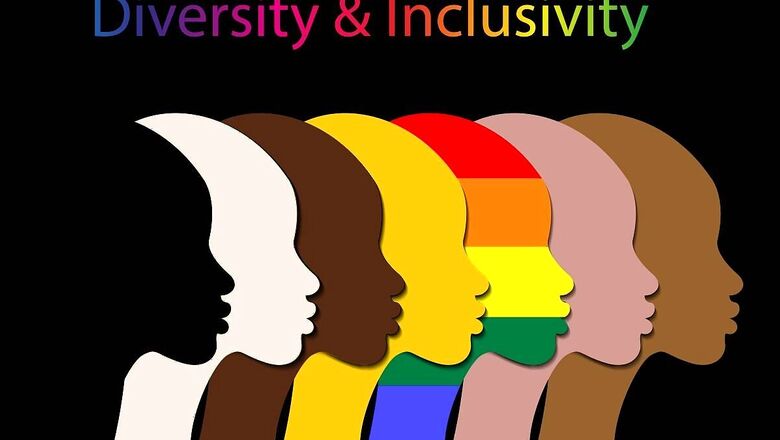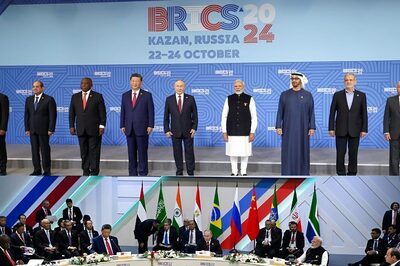
views
If you’re a cisgender man or woman, toilets are something you take for granted. You have a dedicated place to go to, and you don’t have to think twice about whether or not you’ll be welcome there. For LGBTQ+ individuals, however, accessing public toilets involves navigating a minefield of judgment, discrimination and fear.
In many ancient cultures, including India’s, there was a recognition of the existence of more than two genders. This is evident in ancient texts and social structures. The hijra community in India, for example, has a recorded history of over 4,000 years. However, colonial rule and modern biases have led to the marginalization of transgender individuals, particularly evident in accessing public amenities such as toilets.
It shouldn’t be this way. In a world that is taking enormous leaps towards inclusivity, we’ve somehow neglected a very basic need.
The Walls We Must Scale
Public toilets have traditionally been bastions of gender normativity. These binary categorizations do not account for a spectrum of gender identities, making public toilets places of vulnerability and fear, for many amongst us. This vulnerability is compounded by several factors:
Absence of recognition
LGBTQ+ individuals often struggle with the lack of recognition and respect for their gender identity and expression. In India, most public toilets are segregated based on binary symbols representing men and women, implying that only two genders exist and everyone can be easily slotted into these two genders based on their biological sex or appearance. This completely neglects transgender and non-binary individuals who do not identify with the gender they were assigned by biology or birth.
Consequently, deciding which toilet to use can be an incredibly fraught experience: it morphs into a difficult and anxiety-inducing decision, exposing them to potential harassment, discrimination, or violence from other users or staff who perceive them as using the “wrong” toilet.
Safety Concerns
For the LGBTQ+ community, particularly transgender individuals, public toilets can be dangerous places. This isn’t just the case in India, but the world over. A study conducted in the United States revealed that 59% of transgender or gender-diverse participants avoided using public toilets due to fear of confrontations. The Indian narrative parallels these experiences and statistics, with countless members of the transgender community opting to refrain from using public toilets altogether to avoid confrontations that could escalate to violence.
Health Implications
The repercussions of avoiding public toilets are dire, as most of us know. While the Swachh Bharat Mission has made toilets available to all of us today, we all remember a time when we used to ‘hold it’ because the places we visited didn’t have toilets, or if they had them, were too dirty and unsafe to use. Today, that time is thankfully in the past – whether we’re out on a road trip, in our offices, or at a large sporting event, we have access to hygienic and safe toilets.
Not so for the transgender and non-binary amongst us. They still have to ‘hold it’, not because we don’t have toilets, but because they don’t feel safe using them. Many of them resort to restricting their food and water intake to evade the challenges associated with using public toilets. This self-imposed restriction leads to the development of urinary tract infections, kidney problems, and other related health issues. These problems encompass dehydration, urinary tract infections, kidney infections, and various complications arising from prolonged urine retention.
Furthermore, the avoidance of public toilets can limit LGBTQ+ individuals’ access to education, employment, healthcare, recreational activities, and other essential public services and spaces.
Psychological Stress
If you’ve been under stress for a prolonged period of time, you know how it plays out on your mental health. For a moment, put yourself in the shoes of a transgender person. Think about what it feels like to have to keep yourself in a state of alertness at all times – you don’t know who is offended by your mere presence, who is bigoted enough to want to attack you, who will keep you from using ‘their’ bathroom at work, school, or at the local train station. Think about your levels of anxiety and hypervigilance, on a daily basis.
This constant state of alertness and anxiety extracts its price. According to a study, among the transgender and/or nonbinary youth who experienced bathroom discrimination, 85% reported depressive mood and 60% seriously considered suicide. Furthermore, 1 in 3 transgender and/or nonbinary youths who experienced bathroom discrimination reported a past-year suicide attempt, with 1 in five reporting multiple suicide attempts.
Of course, the bathroom discrimination is a symptom of a larger disease that is chipping away at these young people.
Legal Hurdles
Despite the decriminalization of homosexuality in India in 2018, there remains a significant lack of comprehensive policies aimed at safeguarding the safety and preserving the dignity of LGBTQ+ individuals in public spaces, including public toilets. While the legal landscape has progressed, the implementation of inclusive measures to protect the rights of the LGBTQ+ community in everyday settings is still lagging behind. This dearth of policies perpetuates an environment where LGBTQ+ individuals continue to face discrimination, harassment, and violence, particularly when accessing public facilities such as toilets.
Adequacy Deficit
Another challenge that LGBTQ+ people face is the lack of adequacy of public toilets. For example, some public toilets may not have enough stalls or privacy partitions, which can make some LGBTQ+ people feel exposed or vulnerable. Some public toilets may not have sanitary bins or dispensers for menstrual products, which can affect LGBTQ+ people who menstruate regardless of their gender identity.
Awareness Deficit
Public knowledge on gender identities and the challenges faced by the LGBTQ+ community is often limited. This lack of awareness can breed bias and perpetuate damaging stereotypes.
The Time for Change
A beautiful transformation is unfolding as the winds of change carry us forward. Society, awakened to the importance of inclusivity, is embarking on pioneering initiatives and fervent advocacy. With every gender-neutral toilet that is constructed, we take a colossal leap towards a world where individuals can access toilet facilities without the looming fear of judgment or harassment.
By embracing a more inclusive approach, we can ensure that every toilet option is adorned with clear signage, with language and symbols that exude respect and embrace diversity. It is by dismantling discriminatory bathroom bills and fervently advocating for protective legislation that we become the guardians of LGBTQ+ rights, guaranteeing their sacred dignity and unwavering safety.
A profound shift occurs when we empower LGBTQ+ individuals to be active participants in the planning and design of public toilets. Their invaluable insights and experiences shape facilities that not only meet their unique needs but also serve as welcoming havens for the entire community. By working together, we create spaces that are welcoming to all of us, belonging to all of us, and safe for all of us.
Harpic, a brand renowned for its commitment to cleanliness, has embraced this call for change. With open hearts and a deep understanding, the brand has taken remarkable strides to ensure that its products cater to the rich tapestry of society, which includes the LGBTQ+ community. Recognizing that education is the key to transforming attitudes, Harpic has launched inspiring campaigns that illuminate the beautiful diversity of gender identities. Through these powerful initiatives, society is awakened, nurtured, and encouraged to create environments where acceptance thrives.
One remarkable collaboration between Harpic and News18, known as ‘Mission Swachhta aur Paani,’ transcends the concept of cleanliness alone. It is a movement that recognizes the profound significance of toilets, viewing them not merely as functional spaces but as beacons of safety and acceptance for the marginalized. This exceptional mission is built upon the firm belief that clean and inclusive toilets are vital for fostering a society that embraces and empowers us all, unconditionally. With unwavering dedication, Harpic and News18 actively include and advocate for the LGBTQ+ community, propelling the message that every individual deserves access to safe and accepting spaces, where their dignity is upheld, and their presence is celebrated.
Conclusion
Inclusion is not a checkbox, but a journey of embracing diversity.
As we step into a world that is slowly shedding the shackles of prejudice, it is our collective responsibility to ensure that public spaces, toilets included, are safe havens for all, irrespective of gender identity. Through legislative reforms, awareness campaigns, and corporate responsibility, as exemplified by Harpic and News18’s ‘Mission Swachhta aur Paani’, we can transition from a society clouded by stigma to one that sees, accepts and respects all of us, as we are.
To know more about how you can play a part in this national conversation, join us here.




















Comments
0 comment